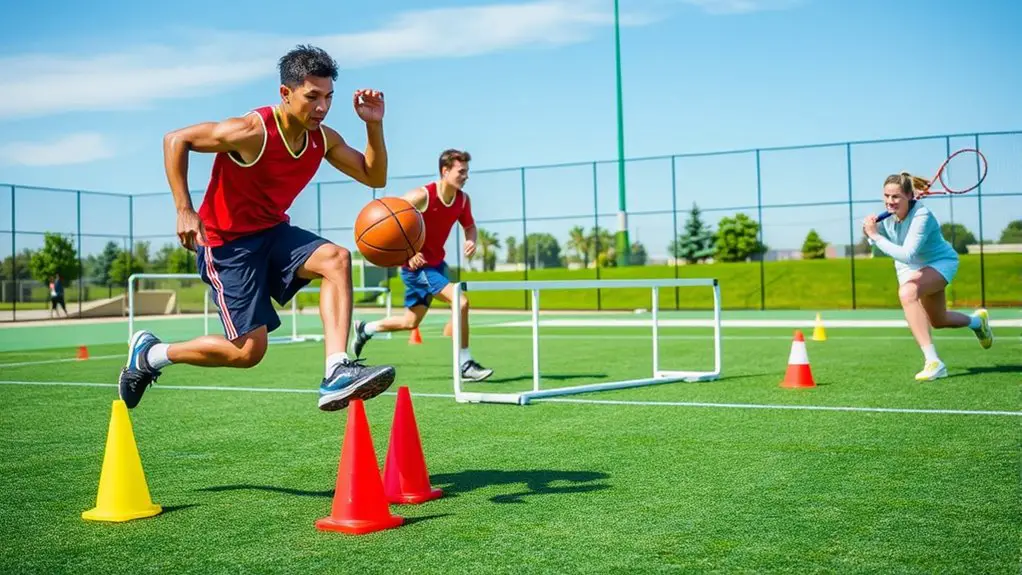Understanding swing mechanics in baseball involves mastering your stance, grip, load phase, stride, and swing path. Each element plays an essential role in maximizing power and precision. A proper stance balances your weight, while grip type influences control. The load phase builds energy, and your stride guarantees timing. The swing path dictates angle and trajectory, leading to effective hits. If you're curious about refining your technique and enhancing your performance, there's more to explore.
The Importance of Proper Stance
When you step up to the plate, your stance sets the tone for your entire swing. It's your first opportunity to express freedom and control over the game. Stance adjustments are essential; they help you find that perfect position for an effective swing. Whether you're feeling tight or loose, minor tweaks can drastically change your performance.
Focus on balance techniques, too. A solid foundation allows you to harness your energy and transfer it into the swing. Keep your feet shoulder-width apart, and distribute your weight evenly. This stability gives you the freedom to react to the pitch without losing control.
Grip and Bat Position
A proper grip and bat position are vital for maximizing your swing's power and accuracy. You'll want to explore various bat grip techniques to find what feels natural for you. An ideal bat angle is essential; it enables better contact with the ball while maintaining control.
Here's a quick guide to help you understand different grips and their benefits:
| Grip Type | Benefits | Ideal Bat Angle |
|---|---|---|
| Traditional | Better control, classic feel | 45° |
| Knobless | Increased whip, power focus | 30° |
| One-Handed | Improved wrist strength | 50° |
| Finger Split | Enhanced bat speed | 40° |
| Overlapping | Stability and balance | 35° |
Experiment with these techniques to find what works best for your style. Remember, the right grip can make all the difference in your performance!
The Load Phase: Building Energy
In the load phase, your body positioning is vital for generating power in your swing. You'll need to master weight transfer techniques to effectively harness that energy, and timing and rhythm play a key role in executing your movement. Understanding these elements will set the foundation for a powerful hit.
Body Positioning Importance
Although many players focus on the swing's final mechanics, body positioning during the load phase is essential for building energy. Proper body alignment sets the stage for effective rotational movement, allowing you to harness your body's natural power. When you nail this phase, you're not just preparing to swing; you're liberating your potential.
- Feel the rush of energy building within you.
- Embrace the freedom of fluid motion.
- Experience the thrill of perfect alignment.
- Ignite your passion for the game.
Weight Transfer Techniques
While you might be enthusiastic to swing, mastering weight transfer during the load phase is essential for maximizing your power. To harness that energy, you need to focus on effective weight distribution strategies. Start by shifting your weight onto your back foot, allowing your body to coil and store potential energy. This action optimizes the kinetic chain, setting the stage for a powerful swing. As you prepare to launch, feel the shift of your weight smoothly moving to your front foot. This fluidity is vital; any hesitation can rob you of momentum. Remember, practicing these techniques will not only enhance your swing but also give you the freedom to express your natural athleticism. Embrace the process; it's all about building energy!
Timing and Rhythm
Timing and rhythm are essential elements during the load phase of your swing, acting as the heartbeat that drives your energy. When you master these concepts, you'll feel a sense of freedom and flow, enhancing your performance at the plate. Implementing timing drills and rhythm exercises can help you connect with your body and the game, allowing you to release your full potential.
- Experience the thrill of perfect timing
- Feel the rhythm coursing through your muscles
- Embrace the freedom of a well-executed swing
- Discover the joy in the dance between you and the pitch
The Stride: Timing and Balance
As you prepare to swing, the stride plays an essential role in establishing both timing and balance. It's your moment to connect with the pitch, and proper stride mechanics can make all the difference. Start by shifting your weight onto your back leg, then take a controlled step forward. This motion sets the stage for a fluid swing while keeping you grounded.
Utilizing balance techniques is vital; you want to feel stable and ready. Keep your head steady and your eyes on the ball. Your stride shouldn't be too long or too short—find that sweet spot that feels natural for you. This balance lets you adjust quickly and react to the pitch, enhancing your overall performance. Embrace the freedom of movement, and remember that each stride is a chance to refine your technique, ensuring you're set up perfectly for a powerful swing.
The Swing Path: Angles and Trajectory
After establishing your stride, the next key element to focus on is the swing path, which directly impacts the angle and trajectory of the ball. Your swing angles determine how effectively you can connect with the pitch, making trajectory optimization essential for achieving those soaring hits. By mastering your swing path, you'll discover the freedom to send the ball flying.
Mastering your swing path unlocks the power to elevate your hits and connect with the ball like never before.
- Feel the rush of the perfect hit
- Experience the thrill of watching the ball soar
- Embrace the joy of a well-timed swing
- Celebrate the freedom that comes with precision
As you refine your swing path, visualize the angles that lead to success. You're not just swinging a bat; you're creating art in motion. Each swing offers a chance to explore your potential, allowing you to express yourself on the field like never before. Embrace the journey, and let your swing speak for itself!
Contact Point: The Critical Moment
The contact point in baseball is where the magic happens, marking the critical moment that can make or break your swing. This moment hinges on your contact timing; it's crucial to synchronize your swing with the pitch for ideal results. When you hit the ball at the right time, you release maximum impact force, sending the ball soaring.
Think of it as a dance between you and the pitch—a split-second decision that dictates your success. If you're too early or late, you lose that sweet spot and risk weak contact or a miss altogether.
To harness this power, focus on your stance and approach. Visualize the ball's trajectory and prepare yourself to react instinctively. Mastering the contact point lets you express your freedom in the game, turning every swing into a potential masterpiece. Embrace this moment, and you'll elevate your performance at the plate.
Follow-Through: Deceleration and Control
Once you've made contact, the follow-through becomes essential for maintaining control and deceleration. It's the moment when you can truly feel the freedom of your swing, channeling energy into finesse rather than force. Mastering deceleration techniques is key, allowing you to guide your bat through the finish instead of just letting it drop. This swing control not only enhances your performance but also makes your movements fluid and expressive.
- Feel the connection with the bat and ball.
- Experience the thrill of a clean, powerful swing.
- Enjoy the rhythm of your body in motion.
- Relish the satisfaction of a well-executed follow-through.
The Role of Body Mechanics
When you step up to the plate, your body mechanics play an essential role in your swing's success. Maintaining proper posture, mastering weight transfer, and coordinating your arm and wrist action can make all the difference in your performance. Let's explore how these elements come together to enhance your swing.
Importance of Posture
Proper posture is essential for effective swing mechanics in baseball, as it sets the foundation for your entire batting performance. When you maintain good spine alignment and make postural adjustments, you're not just optimizing your swing; you're embracing the freedom to express your power and precision at the plate.
- Feel the surge of confidence as you step up to bat.
- Experience the thrill of a perfectly executed swing.
- Relish in the freedom of movement and control.
- Embrace the satisfaction of improving with every practice.
Weight Transfer Techniques
As you prepare to swing, understanding weight transfer techniques is essential for harnessing your body mechanics effectively. The key lies in mastering weight distribution strategies, which allow you to shift your weight fluidly from your back foot to your front foot. This shift activates the kinetic chain, connecting your legs, hips, and core to generate power. Focus on loading your weight onto your back leg before committing to the swing, then smoothly advancing forward. This movement not only enhances your swing's speed but also keeps you balanced. With practice, you'll feel how a proper weight shift elevates your performance, giving you the freedom to swing confidently and with precision. So, embrace these techniques and let your body flow through the motion!
Arm and Wrist Action
The action of your arms and wrists plays an essential role in the effectiveness of your swing in baseball. Your wrist flexibility and arm extension can make the difference between a strikeout and a home run. When you harness the power of these movements, you'll feel liberated on the field.
- Experience the thrill of connecting with the ball.
- Release your full potential with every swing.
- Feel the wind rush past you as you drive the ball.
- Celebrate the freedom of hitting without restraint.
Mental Approach: Focus and Visualization
While physical skills are essential in baseball, your mental approach—especially focus and visualization—can greatly enhance your swing mechanics. When you step up to the plate, harnessing mental imagery can help you picture the perfect swing. Visualize the ball coming toward you, and imagine the contact you want to make. This mental rehearsal can sharpen your instincts and boost your confidence.
Incorporating concentration techniques is just as vital. Find a quiet moment before your at-bat to clear your mind and center your thoughts. Focus on the pitcher, not the crowd or the stakes. By doing this, you'll be more present, allowing your body to react naturally. Additionally, practicing mindfulness in athletic performance can further improve your ability to maintain focus and enhance your overall game.
Analyzing Swing Performance: Tools and Techniques
When it comes to improving your swing, understanding the right tools and techniques is essential. Biomechanical analysis methods can provide valuable insights into your mechanics, while performance tracking technology helps you monitor progress over time. Let's explore how these resources can enhance your swing performance.
Biomechanical Analysis Methods
As you explore the world of swing mechanics, understanding biomechanical analysis methods becomes essential for evaluating swing performance effectively. These methods let you dive deep into the intricacies of a swing, offering insights that can elevate your game to new heights.
- Feel the thrill of precision with kinematic analysis.
- Release your potential by measuring force accurately.
- Discover the freedom of a perfectly timed swing.
- Transform your practice sessions into a journey of self-discovery.
Performance Tracking Technology
To enhance your swing performance, integrating performance tracking technology is essential. By leveraging sensor technology and wearable devices, you can gather swing metrics that transform your understanding of your technique. Real-time tracking allows for immediate player feedback, giving you the insights needed for performance enhancement. Motion capture and data analytics will help you visualize your swings, while statistical analysis reveals patterns and areas for improvement. Creating feedback loops based on this data guarantees that you're constantly refining your skills. Embracing these innovations not only empowers you to elevate your game but also allows for a more personalized approach to training. With the right tools, you can release your full potential and enjoy the freedom of mastery in your swing mechanics.
Frequently Asked Questions
How Does Bat Weight Affect Swing Mechanics?
Imagine your bat as an extension of your own arm, dancing through the air. The weight of that bat plays an essential role in your swing mechanics. A heavier bat can slow your bat speed, making it harder to achieve that perfect swing path. But a lighter bat might give you the freedom to whip it faster, allowing for more control and power. Finding the right balance lets you release your potential on every swing.
Can Swing Mechanics Vary by Player Position?
Absolutely, swing mechanics can vary by player position. Each position has its own demands, leading to position-specific techniques. For instance, a catcher might focus on quick, compact swings, while an outfielder may prioritize power and extension. Your hitter profile matters too; if you're known for contact hitting, you might adapt your mechanics differently than a power hitter. Embracing these variations lets you harness your unique strengths and adapt your game to fit your style.
What Role Does Fatigue Play in Swing Performance?
Fatigue plays a significant role in swing performance. When you're tired, fatigue effects can lead to a performance decline, making it harder to maintain proper mechanics and timing. Your muscles may not respond as quickly, and your focus might waver, impacting your overall effectiveness. It's essential to recognize when you're fatigued and take breaks to recharge. Staying fresh helps keep your swing sharp and allows you to perform at your best.
How Can Weather Conditions Impact Swing Mechanics?
Oh sure, just swing away in a sauna! Weather's a real game-changer, isn't it? Humidity effects can make you feel like you're swinging through molasses, while temperature variations can either freeze your muscles or turn them into spaghetti. When it's too hot or humid, you're not just battling the pitcher; you're fighting the elements. So, dress for the weather, or you might find yourself swinging like you're stuck in quicksand.
Are There Specific Drills to Improve Swing Mechanics?
If you're looking to enhance your swing, specific swing drills can really help. Start with slow-motion swings to focus on your mechanics analysis; this'll let you identify areas needing improvement. Incorporate tee work to practice contact points, and use video to review your form. Don't forget to mix in some live pitching to replicate game situations. With consistent effort in these drills, you'll feel the freedom to swing with confidence and precision!




